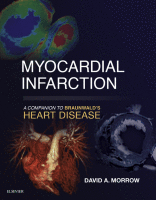Physical Address
304 North Cardinal St.
Dorchester Center, MA 02124

Introduction Myocardial infarction (MI) caused by coronary artery disease remains the leading cause of death in the United States (see Chapter 2 ). Although the advent of coronary care units and early reperfusion therapy has decreased in-hospital mortality rates for…

Introduction Myocardial infarction (MI) is defined by myocyte necrosis. If large in its territory or critical in its location, this injury can lead to loss of contractile function or other structural complications (see Chapter 26 ) that result in insufficient…

Introduction The term “reperfusion injury” refers to cellular damage that occurs during the reperfusion phase after an episode of ischemia. If reperfusion occurs after a short period of ischemia, all cells are salvaged ( Figure 24-1A ). However, as the…

Introduction There has been a major decline in the incidence of myocardial infarction (MI) in the developed world, with the proportion of ST-elevation MI (STEMI) decreasing and the proportion of non–ST-elevation MI (NSTEMI) increasing (see Chapter 2 ). As survival…

Acknowledgments This work was supported in part by NIH grants P01 HL-78825 and UM1 HL-113530 (CCTRN). Introduction Cell-based therapy is an exciting new treatment modality that has the potential to revolutionize cardiovascular (CV) medicine. Research on the application of cell…

Introduction Despite improvements in secondary preventive care and risk factor modification, there is a persistently elevated risk of recurrent cardiovascular (CV) events after experiencing a myocardial infarction (MI), with more than 10% of patients developing recurrent MI, refractory angina, hospitalization,…

Introduction The combination of aspirin with P2Y 12 inhibitors, which is also known as dual antiplatelet therapy, is the standard of care for oral antiplatelet treatment in patients presenting with an acute coronary syndrome (ACS) and/or who are undergoing percutaneous…

Introduction Atherosclerotic plaque rupture followed by arterial thrombosis is the major determinant that leads to an acute coronary syndrome (ACS). Platelet adhesion, activation, and aggregation have a pivotal role in the cascade of events that lead to arterial thrombosis, and…

Introduction Myocardial infarction (MI) includes patients presenting with ST-elevation MI (STEMI) and those without ST-segment MI (NSTEMI), and although these types of MI share a common physiopathology and principles of treatment (see Chapter 13 ), the approaches to management of…

Introduction Percutaneous coronary intervention (PCI) is the dominant strategy used for coronary revascularization in acute myocardial infarction (MI). In the United States, approximately 600,000 patients are discharged from the hospital with a principal diagnosis of acute MI (see Chapter 2…